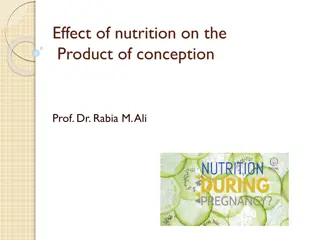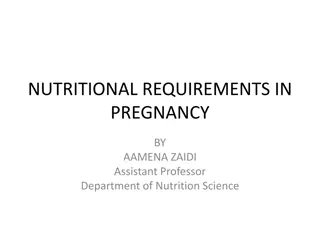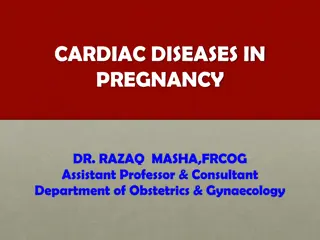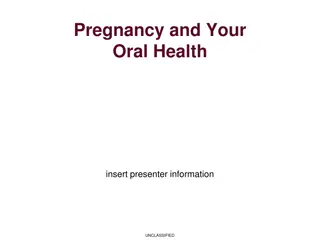Physiological Changes During Pregnancy: A Detailed Overview
Explanation of physiological changes in pregnancy including genital, breast, blood volume, and composition, as well as skin changes. Details on changes in the uterus, breast size, blood circulation, hormones, gastrointestinal motility, skin pigmentation, and more are covered.
Uploaded on Sep 22, 2024 | 4 Views
Download Presentation

Please find below an Image/Link to download the presentation.
The content on the website is provided AS IS for your information and personal use only. It may not be sold, licensed, or shared on other websites without obtaining consent from the author.If you encounter any issues during the download, it is possible that the publisher has removed the file from their server.
You are allowed to download the files provided on this website for personal or commercial use, subject to the condition that they are used lawfully. All files are the property of their respective owners.
The content on the website is provided AS IS for your information and personal use only. It may not be sold, licensed, or shared on other websites without obtaining consent from the author.
E N D
Presentation Transcript
Subject: Nutrition and Dietetics Subject Code: 16SCCND4
Physiological changes during pregnancy UNIT 1
Genital changes The body of the uterus Height and weight (hyperplasia)-increase in size the height increases from 7.5 cm to 35cm the weight increases from 50g to 1000g at term During pregnancy at term, the uterus measures 38cm in length and 24 to 26cm in width. -
Breast changes Increased size Increased pigmentation of the nipple and areola - The darkening of nipples and areolas along with other parts of your body is primarily a result of over- pigmentation of melanin. -warm, dense and tender Secondary areola appear - a second ring appearing around the areola of the breast during pregnancy that is more pigmented than the areola before pregnancy Montgomery tubercules appear on the areola -Montgomery s tubercles are sebaceous (oil) glands that appear as small bumps around the dark area of the nipple. (dilated sebaceous glands) Colostrum like fluid is expressed at the end of the 3rdmonth
BLOOD VOLUME AND COMPOSITION Required to allow the blood circulation to the placenta. It carries nutrients & oxygen to the foetus. Blood volume expands by 50% Which results in Decrease in haemoglobin levels, blood glucose, serum levels of albumin, Other serum proteins & water soluble vitamins Tendency to increase in extra cellular fluid Free fatty acids, fat soluble vitamins, lipid fractions increases
PHYSIOLOGICAL CHANGES Decreased ability to taste saltiness. Progesterone level increases Gastrointestinal motility diminishes Relaxes the uterine muscle CONSTIPATION High blood volume produces high glomerular filtration rate. Increased amount of amino acids, glucose appear in the urine So that increased no. of URINARY TRACT INFECTIONS seen in pregnant women.
Skin changes Pigmentation due to increased melanocyte stimulating hormone: - linea nigra: pigmentation of the linea alba, more marked below the umbilicus - chloasma gravidarum: Butterfly pigmentation of the face (mask of pregnancy) Striae gravidarum -Pregnancy stretch marks, is a specific form of scarring of the skin of the abdominal area due to rapid expansion of the uterus as well as sudden weight gain during pregnancy. About 90% of women are affected. - stretch of the abdominal wall rupture of the subcutaneous elastic fibers pink lines - become white after labor
PHYSIOLOGICAL CHANGES The ability to excrete water is lowered. OEDEMA Subcutaneous fat in the abdomen, back & upper thigh serves as an energy reserve for pregnancy & lactation. ROLE OF PLACENTA Regulation of fetal growth & development Exchange of nutrients, oxygen & waste products.
Weight increase There is an increase weight of approximately 12.5 Kg at term. The main increase occurs in the 2nd half of the pregnancy, 0.5 Kg/week In non-pregnant women, the total plasma volume is 2600 ml. By 34 weeks, it increases into 50 %. If it is does not increase there may me still birth, low birth weight babies.
Skeletal changes Increased lumbar lordosis - lordosis is the inward curvature of a portion of the lumbar (lower back) and cervical (upper back) spine. Relaxation of pelvic joints and ligaments due to progesterone and relaxin(a hormone secreted by the placenta that causes the cervix to dilate and prepares the uterus for the action of oxytocin during labour.)
Urinary changes Kidneys - increase in size - hydronephrosis - Hydronephrosis during pregnancy occurs in 43% to 100% pregnant women, and it is more prevalent with advancing trimester. ... Overall, the volume of kidneys during pregnancy increases up to 30%.9. The growth is attributed to increased kidney vascular and interstitial volume rather than any changes in the number of nephrons ... - effective renal plasma flow is increased
Dilatation of the ureters - Atony of the ureteric muscles caused by progesterone and relaxin - hydro-ureter - vesico-ureteric reflux increased ( is a condition in which urine flows backward, from the bladder into the ureters/kidneys. - pressure of the uterus on the ureter affects more the right ureter due to the dextro- rotation of the uterus Changes in the ureter in pregnancy leads to urinary stasis (also known as urinary retention) is a condition in which the bladder is not able to completely empty and pyelitis (inflammation of the renal pelvis.
Urinary changes Frequency of micturation causes: 1st trimester: pressure of the uterus on the bladder late in pregnancy: engagement of the head Urinary output - diminished on a normal fluid intake - increase in tubular reabsorption - extra liters of fluid pass into the renal tubules each day - extracellular water is increased by 6 to 7 liters during pregnancy - this is due to increased amounts of aldosterone progesterone and oestrogen
Gastro-intestinal changes First trimester experience nausea and vomiting Cravings and aversions to food accompanied by decreased ability to taste food Increased progestrone conc relax the uterine muscle to allow for fetal growth but Decrease the GI motility and increase the reabsorption of water constipation Relaxation of lower esophageal sphincter & pressure on the on the stomach from growing uterus cause regurgitation and gastric reflux
Increased salivation (ptyalism) Taste is often altered very early in pregnancy Increase appetite & thirst frequent small snacks Heart burn (reflux oesophagitis) relaxation of the cardiac sphincter due to progesterone and relaxin Hyperemesis gravidarum (HG) is a pregnancy complication that is characterized by severe nausea, vomiting, weight loss, and possibly dehydration.- , morning sickness in 50 % Decreased gastric acidity, which interfere with iron absorption Constipation reduced gut motility due to progesterone increased water and salt absorption
Cardiovascular changes Cardiac output increases Cardiac size increases by 12% Diastolic blood pressure decreases - 1st 2 trisemester - because of peripheral vasodilation(Peripheral vasodilation refers to the widening of blood vessels located in peripheries, especially the veins. but returns to prepregnancy levels in the 3rd trimester Mild lower extremite edema is a normal condition results from the pressure of expanding uterus on the inferior vena cava Blood return to heart decreases- leading to decreased cardiac output- Maternal oxygen req increase - mother feel dyspenic - the heart rate rises synchronously by 10-15 b.p.m. from 70 to 85 b.p.m. - cardiac output begins to rise by 35-40% in a first pregnancy and ~ 50% in later pregnancies
Cardiovascular changes The blood pressure - slight drop in the 2nd trimester small fall in systolic, greater fall in diastolic B.P. -
Respiratory changes Tidal volume rises by 30% in early pregnancy Driven by progesterone 40-50% by term Fall in expiratory reserve and residual volume(Residual volume is the amount of air that remains in a person's lungs after fully exhaling increase the sensitivity of medulla oblongata to CO2 Minute ventilation increases by 45% during pregnancy -Respiratory minute volume (or minute ventilation or minute volume) is thevolume of gas inhaled (inhaled minute volume) or exhaled (exhaled minute volume) from a person's lungs per minute The increased ventilation during pregnancy results from hormonal changes and increased carbon dioxide production
Endocrinal changes Pituitary - anterior pituitary increases in size and activity - posterior pituitary releases oxytocin on the onset of labor Thyroid - increases in size and activity: physiological goiter - most pregnant women are euthyroid Parathyroid increases in size and activity to regulate calcium metabolism
Endocrinal changes Placental hormones Oestrogens - possible actions: 1- induce growth of uterus and control its function 2- responsible for the development of breasts ( with progesterone) 3- alter chemical constitution of connective tissue, become more pliable 4- cause water retention 5- reduce sodium excretion
Metabolic changes Carbohydrate metabolism - pregnancy is hyperlipidaemic and glucosuric - after mid-pregnancy, resistance of insulin develops - plasma glucose concentrations rise, maintained between 4.5-5.5 mmol/L - glucose crosses the placenta, the fetus uses glucose as primary energy substrate,
Metabolic changes Carbohydrate metabolism - carbohydrate deposited in the liver as glycogen - some escapes to general circulation - portion metabolised by the tissues: converted to depot fat stored as muscle glycogen - first noticeable change occurs in blood sugar - tested by giving a load of oral glucose (glucose tolerance test) - the blood sugar, after meal, remains high facilitating placental transfer
Metabolic changes Protein metabolism - positive nitrogen balance - on average 500 g of protein retained by the end of pregnancy - blood and urine urea are reduced Fat metabolism - by 30 weeks, 4Kg are stored in form of depot fat in the abdominal wall, back and thighs modest amount in breasts
PRECONCEPTUAL NUTRITION Women with low body weight (Less than 40 kg) More low birth weight infants Incidence of diabetes can be reduced by good control of blood glucose. 400 to 800 micro gram of folic acid per day reduce the incidence of neural tube defects. Overweight women Fetal death, diabetes, hypertensive disorders & labour abnormalities
THANKYOU FOR PAYING ATTENTION!
Weight gain is produced by: Fetus 3.63-3.88 Kg Placenta 0.48-0.72 Kg Amniotic fluid 0.72-0.97 Kg Uterus and breasts 2.42-2.66 Kg Blood and fluid 1.94-3.99 Kg 9.70-14.55Kg total= Muscle and fat 0.48-2.91 kg
HORMONAL CHANGES Pregnant women experience changes in their endocrine system. Levels of progesterone and estrogens rise continually throughout pregnancy, which suppress the menstrual cycle. Estrogen is mainly produced by the placenta and is associated with fetal well being. Women also experience increased human chorionic gonadotropin ( -hCG); which is produced by the placenta. This maintains progesterone production by the corpus luteum. The increased progesterone production, first by corpus luteum and later by the placenta, functions to relax bronchiolar smooth muscle. Elevated progesterone levels also contribute to an increase in minute ventilation to 50% greater than non-pregnant levels. Prolactin levels increase due to maternal pituitary gland enlargement by 50%. This mediates a change in the structure of the mammary gland from ductal to lobular-alveolar. Parathyroid hormone is increased which leads to increases of calcium uptake in the gut and reabsorption by the kidney. Adrenal hormones such as cortisol and aldosterone also increase. Human placental lactogen (hPL) is produced by the placenta and stimulates lipolysis and fatty acid metabolism by the woman, conserving blood glucose for use by the fetus. It can also decrease maternal tissue sensitivity to insulin, resulting in gestational diabetes.[1]
Body Weight[edit] Illustration of fundal height at various points during pregnancy One of the most noticeable alterations in pregnancy is the gain in weight. The enlarging uterus, the growing fetus, the placenta and liquor amnii, the acquisition of fat and water retention, all contribute to this increase in weight. The weight gain varies from person to person and can be anywhere from 5 pounds (2.3 kg) to over 100 pounds (45 kg). In America, the doctor-recommended weight gain range is 25 pounds (11 kg) to 35 pounds (16 kg), less if the woman is overweight, more (up to 40 pounds (18 kg)) if the woman is underweight.[citation needed]
Breast size[edit] A woman's breasts grow during pregnancy, usually 1 to 2 cup sizes[citation needed]and potentially several cup sizes. A woman who wore a C cup bra prior to her pregnancy may need to buy an F cup or larger bra while nursing.[2]A woman's torso also grows and her bra band size may increase one or two sizes.[3][4]An average of 80% of women wear the wrong bra size,[5]and mothers who are preparing to nurse can benefit from a professional bra fitting from a lactation consultant.[4]Once the baby is born and about 50 to 73 hours after birth, the mother will experience her breasts filling with milk (sometimes referred to as milk coming in ) and at that point changes in the breast happen very quickly. Once lactation begins, the woman's breasts swell significantly and can feel achy, lumpy and heavy (which is referred to as engorgement). Her breasts may increase again in size, by another 1 or 2 cup sizes,[3][4]and individual breast size can vary daily or for longer periods depending on how much the infant nurses from each breast. A regular pattern of nursing is usually established after 8 12 weeks, and a woman's breasts will usually reduce in size, perhaps to about 1 cup size larger than prior to her pregnancy.[3]It has been shown, that changes in breast size during pregnancy could be associated with the sex of the infant. Mothers of female infants have greater changes in breast size than mothers of male infants.[6] Many women and medical professionals[7][8]mistakenly think that breastfeeding causes their breasts to sag (medically referred to as ptosis),[9]and as a result some are reluctant to nurse their infants. In February
Cardiovascular[edit] During the course of pregnancy, blood volume slowly increases by 40 50%.[13]The increase is mainly due to an increase in plasma volume through increased aldosterone. It results in an increase in heart rate (15 beats/min more than usual), stroke volume, and cardiac output. Cardiac output increases by about 50%, mostly during the first trimester. The systemic vascular resistance also slightly decreases due to smooth muscle relaxation and overall vasodilation caused by elevated progesterone. Diastolic blood pressureconsequently decreases between 12 26 weeks, and increases again to pre-pregnancy levels by 36 weeks. If the blood pressure becomes abnormally high, the woman should be investigated for pre-eclampsia and other causes of hypertension. Cardiac function is also modified, with increased heart rate and increased stroke volume. A decrease in vagal tone and increase in sympathetic tone is the cause. Blood volume increases act to increase stroke volume of the heart via Starling's law. After pregnancy the change in stroke volume is not immediately reversed. Cardiac output rises from 4 to 7 liters in the 2nd
Haematology[edit] During pregnancy the plasma volume increases by 50% and the red blood cell volume increases only by 20 30%.[13]Consequently, the hematocrit decreases on lab value; this is not a true decrease in hematocrit, however, but rather due to the dilution. The white blood cell count increases and may peak at over 20 mg/mL in stressful conditions. Conversely, there is a decrease in platelet concentration to a minimal normal values of 100-150 mil/mL. A pregnant woman will also become hypercoagulable, leading to increased risk for developing blood clots and embolisms, due to increased liver production of coagulation factors, mainly fibrinogen and factor VIII (this hypercoagulable state along with the decreased ambulation (exercise involving legs) causes an increased risk of both DVT and PE). Women are at highest risk for developing clots, or thrombi, during the weeks following labor. Clots usually develop in the left leg or the left iliac venous system. The left side is most afflicted because the left iliac vein is crossed by the right iliac artery. The increased flow in
Metabolic[edit] During pregnancy, both protein metabolism and carbohydrate metabolism are affected. One kilogram of extra protein is deposited, with half going to the fetus and placenta, and another half going to uterine contractile proteins, breast glandular tissue, plasma protein, and haemoglobin. An increased requirement for nutrients is given by fetal growth and fat deposition. Changes are caused by steroid hormones, lactogen, and cortisol. Maternal insulin resistance can lead to gestational diabetes. Increased liver metabolism is also seen, with increased gluconeogenesis to increase maternal glucose levels.[citation needed]
Nutrition[edit] Main article: Nutrition and pregnancy Nutritionally, pregnant women require a caloric increase of 300 kcal/day and an increase in protein to 70 or 75 g/day.[citation needed]There is also an increased folate requirement from 0.4 to 0.8 mg/day (important in preventing neural tube defects). On average, a weight gain of 20 to 30 lb (9.1 to 13.6 kg) is experienced.[citation needed] All patients are advised to take prenatal vitamins to compensate for the increased nutritional requirements. The use of Omega 3 fatty acids supports mental and visual development of infants.[14]Choline supplementation of research mammals supports mental development that lasts throughout life.[15]
Renal and lower reproductive tract[edit] A pregnant woman may experience an increase in kidney and ureter size. The glomerular filtration rate (GFR) commonly increases by 50%, returning to normal around 20 weeks postpartum.[13]Plasma sodium does not change because this is offset by the increase in GFR. There is decreased blood urea nitrogen (BUN) and creatinine and glucosuria (due to saturated tubular reabsorption) may be seen. Persistent glucosuria may suggest gestational diabetes. The renin-angiotensin system is upregulated, causing increased aldosterone levels. Pregnancy alters the vaginal microbiota with a reduction in species/genus diversity.[16]
Gastrointestinal[edit] During pregnancy, woman can experience nausea and vomiting (morning sickness); which may be due to elevated B-hCG and should resolve by 14 to 16 weeks.[citation needed]Additionally, there is prolonged gastric empty time, decreased gastroesophageal sphincter tone, which can lead to acid reflux, and decreased colonic motility, which leads to increased water absorption and constipation.
Immune tolerance[edit] Main article: Immune tolerance in pregnancy The fetus inside a pregnant woman may be viewed as an unusually successful allograft, since it genetically differs from the woman.[17]In the same way, many cases of spontaneous abortion may be described in the same way as maternal transplant rejection.[17]
Musculoskeletal[edit] Neuromechanical adaptations to pregnancy refers to the change in gait, postural parameters, as well as sensory feedback, due to the numerous anatomical, physiological, and hormonal changes women experience during pregnancy. Such changes increase their risk for musculoskeletal disorders and fall injuries. Musculoskeletal disorders include lower-back pain, leg cramps, and hip pain. Pregnant women fall at a similar rate (27%) to women over age of 70 years (28%). Most of the falls (64%) occur during the second trimester. Additionally, two-thirds of falls are associated with walking on slippery floors, rushing, or carrying an object.[18]The root causes for these falls are not well known. However, some factors that may contribute to these injuries include deviations from normal posture, balance, and gait. The body's posture changes as the pregnancy progresses. The pelvis tilts and the back arches to help keep balance. Poor posture occurs naturally from the stretching of the woman's abdominal muscles as the fetus grows. These muscles are less able to contract and keep the lower back in proper
Lumbar lordosis[edit] To positionally compensate the additional load due to the pregnancy, pregnant mothers often extend their lower backs. As the fetal load increases, women tend to arch their lower backs, specifically in the lumbar region of their vertebral column to maintain postural stability and balance. The arching of the lumbar region is known as lumbar lordosis, which recovers the center of mass into a stable position by reducing hip torque. According to a study conducted by Whitcome, et al., lumbar lordosis can increase from an angle of 32 degrees at 0% fetal mass (i.e. non-pregnant women or very early in pregnancy) to 50 degrees at 100% fetal mass (very late in pregnancy). Postpartum, the angle of the lordosis declines and can reach the angle prior to pregnancy. Unfortunately, while lumbar lordosis reduces hip torque, it also exacerbates spinal shearing load,[19]which may be the cause for the common lower back pain experienced by pregnant women.[20]
Males vs. females[edit] Given the demands of fetal loading during pregnancy and the importance of producing offspring to the fitness of human beings, one can imagine that natural selection has had a role in selecting a unique anatomy for the lumbar region in females. It turns out that there are sex differences in the lumbar vertebral column of human males and females, which ultimately helps mitigate some of the discomfort due to the fetal load in females. There are 5 vertebrae in the lumbar region for both males and females. However, the 3 lower vertebrae of a female's lumbar region are dorsally wedged while for males, only the lower 2 of the lumbar region are dorsally wedged. When a female arches her lower back, such as during fetal loading, having an extra dorsally wedged vertebra lessens the shearing force. This lumbar sexual dimorphism in humans suggests high natural selection pressures have been acting to improve maternal performance in posture and locomotion during pregnancy.[19]
Evolutionary implication[edit] If natural selection has acted on the lumbar region of Homo Sapiens to create this sexual dimorphism, then this sort of trait should also be apparent in the genus Australopithecus, hominins that have been known to be habitually bipedal for at least 2 million years after the earliest bipedal hominins. Currently there are 2 nearly complete australopith lumbar segments; one has three dorsally wedged vertebrae in the lumbar region while the other has two. An explanation for these findings is that the first one is a female, while the latter is a male. This sort of evidence supports the notion that natural selection has played a dimorphic role in designing the anatomy of the vertebral lumbar region.[19]
Postural stability[edit] The main anatomical planes of the human body, including median (red), parasagittal (yellow), frontal or coronal plane (blue) and transverse or axial plane (green). The weight added during the progression of pregnancy also affects the ability to maintain balance. In biomechanics, balance refers to one s ability to maintain the center of gravity within the base of support with minimal postural sway. In other words, the moment (or torque) generated by gravity must be balanced by the ankle moment in order to maintain postural stability. Although quiet standing appears to be static, it is actually a process of rocking from the ankle in the sagittal plane.[21]
Symptoms and discomforts of pregnancy From Wikipedia, the free encyclopedia Symptoms and discomforts of pregnancy are those presentations and conditions that result from pregnancy but do not significantly interfere with activities of daily living or pose any significant threat to the health of the mother or baby, in contrast to pregnancy complications. Still, there is often no clear separation between symptoms versus discomforts versus complications, and in some cases the same basic feature can manifest as either a discomfort or a complication depending on the severity. For example, mild nausea may merely be a discomfort (morning sickness), but if severe and with vomiting causing water-electrolyte imbalance it can be classified as a pregnancy complication (hyperemesis gravidarum).
Nausea (morning sickness)[edit] Main article: Morning sickness Morning sickness occurs in about seventy percent of all pregnant women, and typically improves after the first trimester.[1]Although described as "morning sickness", women can experience this nausea during afternoon, evening, and throughout the entire day. Unfortunately there is no strong evidence showing one treatment that works for all women. Ginger may help some women but the results change from study to study.[2] Bleeding[edit] It is common to have bleeding in early pregnancy, as many women still get their regular monthly period during the first month of their pregnancy. Some women also experience small bleeding associated with implantation. Back pain[edit] Back pain is common in pregnancy, can be very debilitating and can worsen in later pregnancy.[3][needs update][4]Estimates of prevalence ranging from 35% to 61% have been reported, with half or more beginning from
Pelvic girdle pain[edit] Main article: Pelvic girdle pain Pelvic girdle pain is complex and multi-factorial and likely to be represented by a series of sub-groups with different underlying pain drivers from peripheral or central nervous system,[8]altered laxity/stiffness of muscles,[9]laxity to injury of tendinous/ligamentous structures[10]to 'mal-adaptive' body mechanics.[8]Musculo-Skeletal Mechanics involved in gait and weightbearing activities can be mild to grossly impaired. PGP can begin peri or postpartum. Land or water based exercise may help prevent and treat lower back and pelvic pain but research on this subject is low quality.[11]There is pain, instability or dysfunction in the symphysis pubis and/or sacroiliac joints. Carpal tunnel syndrome[edit] Occurs in between an estimated 21% to 62% of cases, possibly due to edema.[12] Leg cramps[edit] Leg cramps (involuntary spasms in calf muscles) can affect between 30%
Contractions[edit] Occasional, irregular, painless contractions that occur several times per day are normal and are known as Braxton Hicks contractions. Can be aggravated by dehydration which will respond to increased fluid intake. Regular contractions (every 10 15 min) are a sign of preterm labor and should be assessed by cervical exam. Dehydration[edit] Caused by expanded intravascular space and increased third spacing of fluids. Complications include uterine contractions, which may occur because dehydration causes body release of ADH, which is similar to oxytocin in structure. Oxytocin itself can cause uterine contractions and thus ADH can cross-react with oxytocin receptors and cause contractions. Edema[edit] Compression of the inferior vena cava (IVC) and pelvic veins by the uterus leads to increased hydrostatic pressure in lower extremities. Treatment includes raising legs above the heart, advising patient to sleep on her side to prevent the uterus from impinging on the inferior vena
Varicose veins[edit] Dilation of veins in legs caused by relaxation of smooth muscle and increased intravascular pressure due to fluid volume increase. Treatment involves elevation of the legs and pressure stockings to relieve swelling along with warm sitz baths to decrease pain. There is a small amount of evidence that rutosides (a herbal remedy) may relieve symptoms of varicose veins in late pregnancy but it is not yet known if rutosides are safe to take in pregnancy.[18]Risk factors include obesity, lengthy standing or sitting, constrictive clothing and constipation and bearing down with bowel movements Hemorrhoids[edit] Haemorrhoids (piles) are swollen veins at or inside the anal area, resulting from impaired venous return, straining associated with constipation, or increased intra-abdominal pressure in later pregnancy.[20]They are more common in pregnant than non-pregnant women.[20]It is reported by 16% of women at 6 months postpartum.[21]Most pregnant women in countries where the diet is not heavily fiber-based may develop























